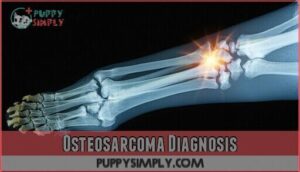This site is supported by our readers. We may earn a commission, at no cost to you, if you purchase through links.
 Knowing what right time to euthanize a dog with osteosarcoma comes down to watching for clear signs your pup’s suffering outweighs their joy.
Knowing what right time to euthanize a dog with osteosarcoma comes down to watching for clear signs your pup’s suffering outweighs their joy.
When pain medications can’t keep them comfortable anymore, they’re struggling to stand or walk, and they’ve lost interest in favorite activities like treats or belly rubs, it’s time for that heartbreaking conversation with your vet.
You’ll see it in their eyes—that spark that made them uniquely yours starts to dim.
Most dogs with osteosarcoma face this decision within 3-6 months of diagnosis, but every situation’s different. Quality of life scales can help you make this compassionate choice objectively when emotions cloud judgment.
Table Of Contents
- Key Takeaways
- What is Osteosarcoma in Dogs?
- What Causes Osteosarcoma in Dogs?
- Canine Osteosarcoma Symptoms
- Dog Breed Prone to Osteosarcoma
- Osteosarcoma Diagnosis
- Osteosarcoma in Dogs Treatment
- Osteosarcoma Dog Prognosis
- Canine Osteosarcoma Prognosis Without Treatment
- Ways to Help Your Dog With Osteosarcoma
- Deciding if You Should Euthanize Your Dog
- Frequently Asked Questions (FAQs)
- When is the right time to euthanize a dog with osteosarcoma?
- When should I euthanize my Dog with cancer?
- When should you euthanize a suffering dog?
- What are the treatment options for osteosarcoma in dogs?
- Does my dog need surgery for osteosarcoma?
- What is the prognosis of osteosarcoma in dogs?
- What is the right time to euthanize a dog with osteosarcoma?
- When to humanely euthanize a dog with cancer?
- Is it better to euthanize a dog early or late?
- What is the end of life for osteosarcoma in dogs?
- Conclusion
Key Takeaways
- Watch for clear signs of declining quality of life – You’ll know it’s time when pain medications can’t keep your dog comfortable anymore, they’re struggling with basic functions like walking or eating, and they’ve lost interest in activities they once enjoyed.
- Don’t wait until suffering becomes unbearable – Most dogs with osteosarcoma face this decision within 3-6 months of diagnosis, and choosing euthanasia before your dog’s pain becomes unmanageable is more compassionate than waiting too long.
- Use objective quality of life assessments – You can rely on quality of life scales and your veterinarian’s guidance to make this decision more objectively when emotions cloud your judgment about your dog’s true comfort level.
- Trust that euthanasia is an act of love, not giving up – The euthanasia process is peaceful and painless, and choosing this option when your dog’s suffering outweighs their joy reflects the deep bond you’ve shared throughout their life.
What is Osteosarcoma in Dogs?
When your dog develops osteosarcoma, you’re facing an aggressive disease that strikes at the very foundation of their mobility.
When osteosarcoma invades your dog’s bones, every step becomes a battle against relentless pain.
This bone cancer occurs when cells malfunction within the bone, creating malignant tumors that destroy healthy tissue from the inside out.
Unlike other tumor types, osteosarcoma typically targets the limbs, making every step painful for your furry companion.
Understanding this aggressive disease helps you recognize why discussions about dog quality of life and osteosarcoma pain management become vital conversations with your veterinarian.
Addressing such ailments requires consideration of common pet issues to guarantee thorough care.
What Causes Osteosarcoma in Dogs?
Scientists haven’t pinpointed exactly what triggers canine bone cancer, but several factors stack the deck against your dog.
Genetic predisposition plays a major role—certain breeds carry DNA that makes them sitting ducks for this disease. Large breeds face higher breed susceptibility due to their rapid growth patterns and bone stress.
Growth factors during puppyhood may contribute to abnormal cell development. Some researchers suspect bone trauma from injuries or repetitive stress might kickstart tumor formation, while others investigate potential viral influence in cancer development.
Early detection can improve outcomes, but cancer can still occur.
Canine Osteosarcoma Symptoms
Recognizing canine osteosarcoma symptoms early can make all the difference in your dog’s comfort and treatment options.
Watch for these telltale signs that something’s wrong:
- Limping Progression – What starts as occasional favoring of one leg becomes constant limping within weeks
- Swelling Severity – Noticeable lumps or swelling around joints, especially legs, ribs, or jaw
- Pain Management needs – Your dog may whine, pant excessively, or resist normal activities
- Fracture Risk increases as weakened bones break from minor trauma
- Appetite Loss and lethargy signal your pet’s declining comfort
These signs dog suffering warrant immediate veterinary attention for proper diagnosis.
Dog Breed Prone to Osteosarcoma
Size matters in relation to osteosarcoma risk. Large breed dogs and giant breed dogs face substantially higher chances due to genetic predisposition.
Rottweilers, German Shepherds, Golden Retrievers, and Great Danes top the breed statistics list. Dogs weighing over 90 pounds account for nearly one-third of cases, showing clear size correlation.
While you can’t change your dog’s genetics, early detection through regular vet checkups helps catch symptoms sooner.
Preventative measures like proper nutrition and weight management may reduce strain on bones, though they can’t eliminate inherited risks completely.
Osteosarcoma Diagnosis
Early detection starts when your vet notices subtle changes during routine checkups.
Getting an accurate canine osteosarcoma diagnosis involves multiple imaging techniques and careful evaluation to guide your dog cancer decisions.
Your veterinarian will typically follow this diagnostic process:
- X-rays reveal bone destruction – showing characteristic "sunburst" patterns where cancer eats away healthy tissue
- Biopsy types confirm the diagnosis – either needle aspiration or surgical samples provide definitive answers
- Staging methods check for spread – CT scans reveal if cancer has traveled to lungs
- Differential diagnosis rules out other conditions – ensuring it’s truly osteosarcoma affecting your dog’s osteosarcoma prognosis dog and when to euthanize dog considerations.
Osteosarcoma in Dogs Treatment
When your dog receives an osteosarcoma diagnosis, you’ll face important treatment decisions that can substantially impact their comfort and survival time.
Understanding your options—from surgery and chemotherapy to radiation therapy—helps you work with your veterinarian to create the best plan for your dog’s specific situation.
Surgery
Once you’ve received an osteosarcoma diagnosis, surgery becomes the primary battlefield against this aggressive cancer.
Amputation remains the gold standard for tumor removal, offering immediate pain relief and the best chance at extending your dog’s life. While the thought might feel overwhelming, most dogs adapt remarkably well to three-legged life—they don’t mourn their missing limb like we might.
Limbsparing surgery presents an alternative for specific cases, particularly when tumors affect the lower leg bones. However, this option requires careful evaluation of surgical risks and isn’t suitable for every dog. Limb-sparing surgery aims to remove cancerous tissue while preserving limb function.
| Surgical Option | Key Considerations |
|---|---|
| Amputation | Most effective tumor removal method |
| Limb Sparing | Preserves leg function when possible |
| Recovery Time | 2-4 weeks typical healing period |
| Post-op Care | Pain management and restricted activity |
Post-op care involves managing pain medications, monitoring incision sites, and gradually increasing activity levels as your companion heals.
Chemotherapy
While surgery addresses the immediate tumor, chemotherapy tackles the bigger picture by hunting down cancer cells that may have already spread throughout your dog’s body.
This treatment becomes your strongest ally in fighting canine osteosarcoma’s aggressive nature.
Carboplatin leads the pack as the go-to chemo drug type, though your vet might recommend cisplatin or doxorubicin based on your dog’s specific needs.
The standard protocol involves 4-6 treatments spaced three weeks apart, typically starting two weeks after surgery.
This timing gives your pup time to heal while catching stray cancer cells before they establish new tumors.
Here’s the encouraging news: chemo effectiveness rates show dogs receiving treatment have 1-year survival rates up to 71%, compared to just 21% without it.
Chemotherapy aims to control undetectable micrometastasis to improve survival rates.
Chemo side effects like mild nausea or temporary skin changes are generally manageable.
Chemo cost factors vary, but many owners find the extended quality of life invaluable when considering treatment options for their beloved companion.
The use of chemotherapy is a critical component of treatment, and its effectiveness is well-documented.
By understanding the role of chemotherapy in fighting osteosarcoma, you can make informed decisions about your dog’s care.
It is essential to work closely with your vet to determine the best course of treatment for your dog, considering factors such as treatment options and quality of life.
Radiation Therapy
Beyond chemotherapy, radiation therapy offers another pathway for managing your dog’s osteosarcoma.
This treatment uses high-energy beams to target cancer cells while preserving surrounding healthy tissue.
Stereotactic radiotherapy delivers precise, concentrated doses over fewer sessions, making it less stressful for your pet.
Key radiation therapy benefits include:
- Pain relief through palliative benefits without major surgery
- Flexible fractionation schedules adapted to your dog’s needs
- Minimal radiation side-effects compared to other treatments
- Alternative when amputation isn’t suitable
- Helps delay difficult pet euthanasia timing decisions
However, radiation resistance can develop, requiring careful monitoring of your dog’s response to ensure the best possible outcome with minimal side-effects and to provide an alternative to other treatments.
Osteosarcoma Dog Prognosis
Understanding your dog’s canine osteosarcoma prognosis helps you make informed decisions during this challenging time.
Survival rates vary dramatically based on treatment choices and cancer progression.
| Treatment Approach | Average Survival Time |
|---|---|
| No treatment | 2-5 months |
| Amputation alone | 6 months |
| Amputation + chemotherapy | 10-12 months |
Treatment effects substantially impact your dog’s journey.
Advanced bone cancer dogs receiving thorough care often maintain better quality life during their remaining time.
However, metastasis impact changes everything – once cancer spreads beyond the original site, survival drops to under three months regardless of aggressive interventions.
Pain management becomes essential as the disease progresses.
Your veterinarian will monitor dog bone cancer stages to adjust comfort measures accordingly.
While these statistics feel overwhelming, remember that every dog responds differently.
Some exceed expectations, giving families precious extra time together.
Focus on your pet’s individual response rather than averages when considering pet euthanasia timing and dog osteosarcoma euthanasia decisions.
Canine Osteosarcoma Prognosis Without Treatment
Facing osteosarcoma without treatment means confronting harsh realities about your dog’s future.
The canine osteosarcoma prognosis shows a steep quality decline within weeks, making pain management and quality of life critical considerations for dog osteosarcoma euthanasia decisions.
Without intervention, expect:
- Survival Timeline: 2-5 months maximum, often much shorter
- Pain Progression: Severe bone destruction causing unbearable discomfort
- Tumor Growth: Aggressive spread to lungs in 90% of cases
- Fracture Risk: Weakened bones break easily from normal activities
These factors make euthanasia a compassionate choice for many families.
Ways to Help Your Dog With Osteosarcoma
While osteosarcoma presents significant challenges, you can still make meaningful improvements to your dog’s daily life. Creating a thorough support plan helps manage symptoms and maintains their comfort during this difficult time.
Pain Management becomes your top priority. Work with your veterinarian to establish an effective medication routine that keeps your furry friend comfortable.
Mobility Aids like ramps, non-slip mats, and orthopedic beds reduce strain on weakened bones and joints. You may also want to think about a specialized dog bed for added comfort.
| Physical Support | Emotional Support |
|---|---|
| Anti-inflammatory medications | Maintain regular routines |
| Soft bedding and cushioned surfaces | Gentle exercise within limits |
| Easy access to food and water | Quality time and affection |
Nutritional Support through omega-3 supplements and high-quality protein helps maintain strength. Modify your Home Environment by removing stairs and providing easy access to favorite spots.
Remember, small changes create big differences in your dog’s quality of life while managing canine osteosarcoma.
Deciding if You Should Euthanize Your Dog
Making the decision to euthanize your dog with osteosarcoma is one of the hardest choices you’ll face as a pet owner, but it’s often the most compassionate way to end their suffering.
Sometimes the greatest act of love is knowing when to let go.
You’ll need to carefully evaluate your dog’s quality of life, pain levels, and ability to enjoy daily activities to determine the right timing.
How Does Dog Euthanasia Work?
The actual euthanasia process involves a careful, humane dog euthanasia procedure that veterinary professionals handle with compassion. Your vet will typically use an overdose of pentobarbital, administered through an IV line in your dog’s leg.
This painfree euthanasia method works quickly—usually within 10-30 seconds—causing your pet to lose consciousness immediately before their heart stops. Veterinary involvement guarantees the procedure follows ethical euthanasia dog standards.
Most clinics offer aftercare options, including cremation services or burial arrangements. Cost considerations vary by location and services chosen, but many practices provide payment plans to ease financial stress during this difficult time.
The dog euthanasia process itself is peaceful. Your dog won’t experience fear or pain—they’ll simply fall into what appears to be a deep sleep. Many pet parents choose to stay with their companion, offering comfort through gentle words and touch.
Grief support resources are often available through your veterinary clinic to help you navigate this heartbreaking but loving final act. The drug of choice is often pentobarbital.
Considering Quality of Life
Now that you understand the euthanasia process, evaluating your dog’s quality of life becomes the cornerstone of your decision.
Pain management effectiveness tells you everything—when medications can’t control osteosarcoma’s relentless bone pain, your dog’s suffering becomes unbearable.
Watch for mobility issues that prevent normal activities like walking to their food bowl or greeting you at the door.
Appetite changes signal declining health, while reduced social interaction shows emotional withdrawal.
Your dog’s mental wellbeing matters just as much as physical comfort.
Effective dog pain relief can greatly improve quality of life.
Consider pet end-of-life care options that prioritize dignity over quantity of time.
Making the humane dog euthanasia decision means choosing compassion over hope when canine osteosarcoma steals their joy.
Frequently Asked Questions (FAQs)
When is the right time to euthanize a dog with osteosarcoma?
Consider euthanasia when your dog’s pain becomes unmanageable despite medication, they can’t perform basic functions like eating or walking, or their quality of life is severely compromised by constant suffering.
When should I euthanize my Dog with cancer?
You’ll know it’s time when your dog can’t enjoy daily activities, struggles with basic functions, or experiences unmanageable pain despite treatment. Trust your instincts and consult your veterinarian for guidance.
When should you euthanize a suffering dog?
You should euthanize a suffering dog when they can’t enjoy basic activities, eat normally, or move without severe pain.
Trust your veterinarian’s guidance and your heart—you’ll know when it’s time.
What are the treatment options for osteosarcoma in dogs?
You’ve got several paths forward: amputation removes the tumor and pain, chemotherapy extends survival, radiation targets remaining cells, and pain management keeps your dog comfortable throughout treatment.
Does my dog need surgery for osteosarcoma?
Surgery is typically the first line of treatment for osteosarcoma, offering your dog the best chance for pain relief and extended survival. Amputation or limb-sparing surgery removes the tumor effectively.
What is the prognosis of osteosarcoma in dogs?
Your dog’s prognosis with osteosarcoma depends on treatment choices. Without intervention, expect 2-5 months. Amputation with chemotherapy can extend life to 10-12 months, though metastasis substantially reduces survival time.
What is the right time to euthanize a dog with osteosarcoma?
Consider euthanasia when your dog’s pain becomes unmanageable despite medication, they can’t perform basic functions like eating or walking, or their quality of life severely deteriorates.
Consult your veterinarian for guidance.
When to humanely euthanize a dog with cancer?
You’ll know it’s time when your furry companion can’t enjoy life’s simple pleasures anymore—eating favorite treats, wagging at your voice, or moving without obvious distress.
Their suffering outweighs comfort when they can no longer perform these basic actions, signaling obvious distress.
Is it better to euthanize a dog early or late?
Timing euthanasia carefully protects your dog’s quality of life.
You shouldn’t wait until suffering becomes unbearable, but rushing the decision robs precious moments together.
Watch for mobility loss, appetite changes, and persistent pain signals.
What is the end of life for osteosarcoma in dogs?
Max’s owner watched as his Golden Retriever struggled to walk, his breathing labored from lung tumors.
You’ll face worsening pain, difficulty breathing, and loss of mobility as osteosarcoma spreads throughout your dog’s body.
Conclusion
Studies show that 85% of pet owners struggle with the timing decision, but you’re not alone in this difficult journey.
Determining what right time euthanize dog with osteosarcoma requires honest assessment of your companion’s daily comfort and happiness.
Trust your veterinarian’s guidance, use quality-of-life scales objectively, and remember that choosing compassionate euthanasia isn’t giving up—it’s the final act of love you can offer.
Your dog’s peaceful passing reflects the deep bond you’ve shared throughout their life.
- https://veterinarypartner.vin.com/default.aspx?pid=19239&id=4951687
- https://www.akcchf.org/canine-health/your-dogs-health/bone-cancer-in-dogs.html
- https://healthypets.mercola.com/sites/healthypets/archive/2019/10/05/osteosarcoma.aspx
- https://www.morrisanimalfoundation.org/article/osteosarcoma-deadly-bone-tumor-dogs
- https://www.petmd.com/dog/conditions/musculoskeletal/c_multi_osteosarcoma
















